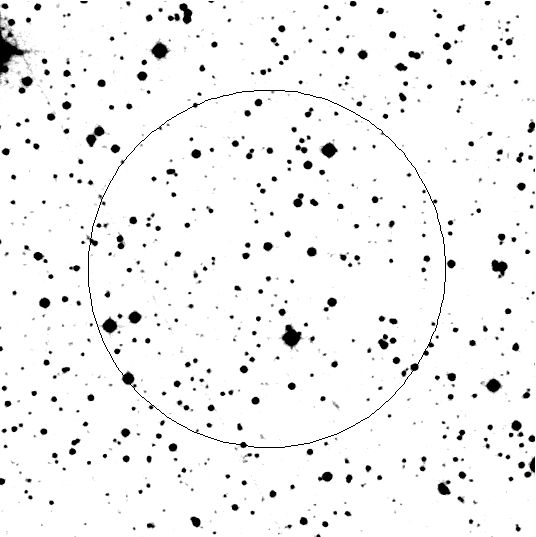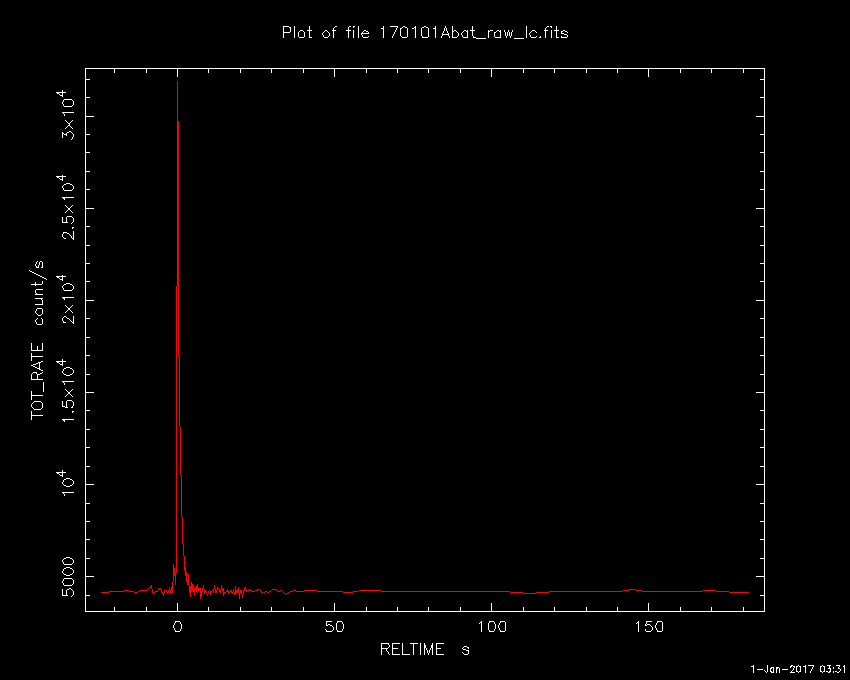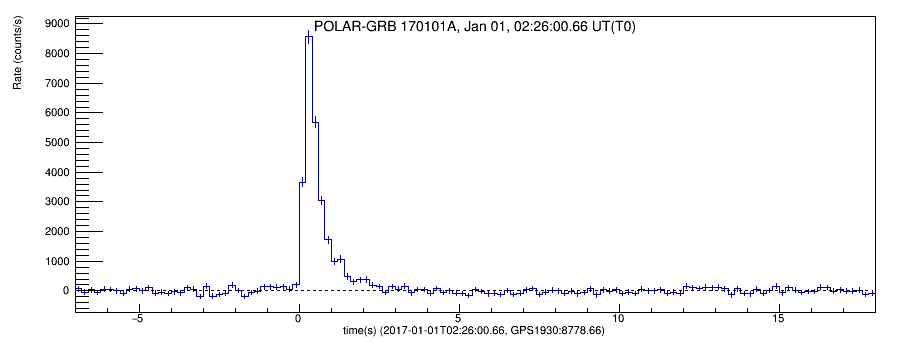- GCN/BACODINE POSITION NOTICE
TITLE: GCN/SWIFT NOTICE
NOTICE_DATE: Sun 01 Jan 17 02:26:29 UT
NOTICE_TYPE: Swift-BAT GRB Position
TRIGGER_NUM: 729293, Seg_Num: 0
GRB_RA: 267.103d {+17h 48m 25s} (J2000),
267.301d {+17h 49m 12s} (current),
266.519d {+17h 46m 05s} (1950)
GRB_DEC: +11.654d {+11d 39' 15"} (J2000),
+11.650d {+11d 38' 58"} (current),
+11.670d {+11d 40' 11"} (1950)
GRB_ERROR: 3.00 [arcmin radius, statistical only]
GRB_INTEN: 1341 [cnts] Image_Peak=186 [image_cnts]
TRIGGER_DUR: 0.064 [sec]
TRIGGER_INDEX: 10420 E_range: 25-100 keV
BKG_INTEN: 17440 [cnts]
BKG_TIME: 8750.60 SOD {02:25:50.60} UT
BKG_DUR: 8 [sec]
GRB_DATE: 17754 TJD; 1 DOY; 17/01/01
GRB_TIME: 8761.80 SOD {02:26:01.80} UT
GRB_PHI: -92.63 [deg]
GRB_THETA: 37.13 [deg]
SOLN_STATUS: 0x3
RATE_SIGNIF: 98.95 [sigma]
IMAGE_SIGNIF: 14.24 [sigma]
MERIT_PARAMS: +1 +0 +0 -4 +2 +3 -100 +0 -79 +0
SUN_POSTN: 281.81d {+18h 47m 14s} -22.99d {-22d 59' 32"}
SUN_DIST: 37.44 [deg] Sun_angle= 1.0 [hr] (West of Sun)
MOON_POSTN: 315.09d {+21h 00m 21s} -15.02d {-15d 01' 10"}
MOON_DIST: 54.32 [deg]
MOON_ILLUM: 8 [%]
GAL_COORDS: 36.48, 19.20 [deg] galactic lon,lat of the burst (or transient)
ECL_COORDS: 266.53, 35.06 [deg] ecliptic lon,lat of the burst (or transient)
COMMENTS: SWIFT-BAT GRB Coordinates.
COMMENTS: This is a rate trigger.
COMMENTS: A point_source was found.
COMMENTS: This does not match any source in the on-board catalog.
COMMENTS: This does not match any source in the ground catalog.
COMMENTS: This is a GRB.
COMMENTS: This trigger occurred at longitude,latitude = 95.63,4.02 [deg].
- red DSS finding chart
ps-file

- GCN NOTICE
TITLE: GCN/SWIFT NOTICE
NOTICE_DATE: Sun 01 Jan 17 02:30:35 UT
NOTICE_TYPE: Swift-BAT GRB Lightcurve
TRIGGER_NUM: 729293, Seg_Num: 0
GRB_RA: 267.103d {+17h 48m 25s} (J2000),
267.301d {+17h 49m 12s} (current),
266.519d {+17h 46m 05s} (1950)
GRB_DEC: +11.654d {+11d 39' 15"} (J2000),
+11.650d {+11d 38' 58"} (current),
+11.670d {+11d 40' 11"} (1950)
GRB_DATE: 17754 TJD; 1 DOY; 17/01/01
GRB_TIME: 8761.95 SOD {02:26:01.95} UT
TRIGGER_INDEX: 10420
GRB_PHI: -92.63 [deg]
GRB_THETA: 37.13 [deg]
DELTA_TIME: -13.00 [sec]
TRIGGER_DUR: 0.064 [sec]
SOLN_STATUS: 0x3
RATE_SIGNIF: 98.95 [sigma]
IMAGE_SIGNIF: 14.24 [sigma]
LC_URL: sw00729293000msb.lc
SUN_POSTN: 281.81d {+18h 47m 15s} -22.99d {-22d 59' 31"}
SUN_DIST: 37.44 [deg] Sun_angle= 1.0 [hr] (West of Sun)
MOON_POSTN: 315.12d {+21h 00m 30s} -15.01d {-15d 00' 43"}
MOON_DIST: 54.35 [deg]
MOON_ILLUM: 8 [%]
GAL_COORDS: 36.48, 19.20 [deg] galactic lon,lat of the burst (or transient)
ECL_COORDS: 266.53, 35.06 [deg] ecliptic lon,lat of the burst (or transient)
COMMENTS: SWIFT-BAT GRB Lightcurve.
COMMENTS:
COMMENTS: The next comments were copied from the BAT_POS Notice:
COMMENTS: This is a rate trigger.
COMMENTS: A point_source was found.
COMMENTS: This does not match any source in the on-board catalog.
COMMENTS: This does not match any source in the ground catalog.
COMMENTS: This is a GRB.
COMMENTS: This trigger occurred at longitude,latitude = 95.63,4.02 [deg].

- GCN Circular #20349
A. Y. Lien (GSFC/UMBC), D. Malesani (DARK/NBI and DTU Space),
B. Mingo (U Leicester), K. L. Page (U Leicester) and
T. N. Ukwatta (LANL) report on behalf of the Swift Team:
At 02:26:01 UT, the Swift Burst Alert Telescope (BAT) triggered and
located GRB 170101A (trigger=729293).
The BAT on-board calculated location is
RA, Dec 267.103, +11.654 which is
RA(J2000) = 17h 48m 25s
Dec(J2000) = +11d 39' 15"
with an uncertainty of 3 arcmin (radius, 90% containment, including
systematic uncertainty). The BAT light curve showed a single-peaked
structure with a duration of about 5 sec. The peak count rate
was ~28000 counts/sec (15-350 keV), at ~0 sec after the trigger.
Due to a Sun observing constraint, Swift cannot slew to the BAT
position until 23:58 UT on 2017 January 19. There will thus be no XRT
or UVOT data for this trigger before this time.
The Swift team wishes the astronomical community a happy 2017.
Burst Advocate for this burst is A. Y. Lien (amy.y.lien AT nasa.gov).
Please contact the BA by email if you require additional information
regarding Swift followup of this burst. In extremely urgent cases, after
trying the Burst Advocate, you can contact the Swift PI by phone (see
Swift TOO web site for information: http://www.swift.psu.edu/too.html.)
- GCN Circular #20353
S. D. Barthelmy (GSFC), J. R. Cummings (CPI),
N. Gehrels (GSFC), H. A. Krimm (NSF/USRA),
A. Y. Lien (GSFC/UMBC), C. B. Markwardt (GSFC),
J. P. Norris (BSU), D. M. Palmer (LANL),
T. Sakamoto (AGU), M. Stamatikos (OSU),
T. N. Ukwatta (LANL) (i.e. the Swift-BAT team):
Using the data set from T-119 to T+303 sec from the recent telemetry downlink,
we report further analysis of BAT GRB 170101A (trigger #729293)
(Lien et al., GCN Circ. 20349). The BAT ground-calculated position is
RA, Dec = 267.089, 11.642 deg which is
RA(J2000) = 17h 48m 21.3s
Dec(J2000) = +11d 38' 29.9"
with an uncertainty of 1.1 arcmin, (radius, sys+stat, 90% containment).
The partial coding was 14%.
T90 (15-350 keV) is 2.43 +- 0.49 sec (estimated error including systematics).
The mask-weighted light curve shows a single FRED-like pulse that starts
at ~T-0.2 s, peaks at ~T0, and ends at ~T+3 s. In addition, there seems to
be some weak emission prior to the FRED-like pulse that starts at ~T-1.6 s,
and a weak tail afterwards that lasts till ~T+8 s. T90 (15-350 keV) is
3.2 +- 0.9 sec (estimated error including systematics).
The time-averaged spectrum from T-1.6 to T+8.5 sec is best fit by a simple
power-law model. The power law index of the time-averaged spectrum is
1.87 +- 0.06. The fluence in the 15-150 keV band is 6.0 +- 0.2 x 10^-6 erg/cm2.
The 1-sec peak photon flux measured from T-0.22 sec in the 15-150 keV band
is 54.4 +- 2.0 ph/cm2/sec. All the quoted errors are at the 90% confidence
level.
Using a 16-ms binned light curve, the lag analysis finds a lag of 39 +/- 8 ms for
the 100-350 keV to 25-50 keV, and 37 +/- 7 ms for the 50-100 keV to 15-25 keV
band, which is consistent with those of a long GRB.
The results of the batgrbproduct analysis are available at
http://gcn.gsfc.nasa.gov/notices_s/729293/BA/
- GCN Circular #20355
Hancheng Li (IHEP), Yuanhao Wang (IHEP), Zhengheng Li (IHEP)
report on the behalf of the POLAR collaboration:
At 2017-01-01T02:26:00.66 UT (T0), during a routine on-ground
search of data, POLAR detected the GRB 170101A, which was also
detected by the Swift/BAT (trigger #729293).
The POLAR light curve consists of a single peak,
with a duration (T90) of 2.82 s measured from T0+0.00 s.
The 0.2-s peak rate measured from T0+0.20 s is 8836 cnts/s,
the total counts is about 5379 cnts. The above measurements
are in the energy range of approximately 80-500 keV.
LC_URL:
http://polar.ihep.ac.cn/grb/2017/01/GRB170101A/lc/GRB170101A.png
Using the best location from the Swfit/BAT, which is (J2000):
RA: 267.103 [deg]
Dec: +11.654 [deg]
Err: 3.00 [arcmin]
the incident angle in POLAR coordinate at T0 is:
theta: 6.04 [deg]
phi: 72.86 [deg]
The Minimum Detectable Polarization(MDP) for this burst is
estimated to be ~6.0% [1-sigma, statistical only].
Follow-up observations are strongly encouraged.
All analysis results presented above are preliminary.
POLAR is a dedicated Gamma-Ray Burst polarimeter (50-500 keV) on-board
the Chinese space laboratory Tiangong-2 launched on Sep 15, 2016.
More information about POLAR can be found at:
http://polar.ihep.ac.cn/en/ ,
http://isdc.unige.ch/polar/ and http://polar.psi.ch/html/ .

- GCN Circular #20359
V.V.Bogomolov, N.L.Dzhioeva, S.I.Svertilov,
A.M.Amelushkin, V.O.Barinova, M.I.Panasyuk, A.V.Bogomolov, A.F.Iyudin,
V.V.Kalegaev, D.Nguen, V.L. Petrov, I.V.Yashin, P.S.Kazarian
Physics Department, Skobel`tsyn Institute of Nuclear Physics, Lomonosov
Moscow
State University
V. Lipunov, E.S. Gorbovskoy, N.Tyurina, D.Kuvshinov
Lomonosov Moscow State University, Sternberg Astronomical Institute
I. Park, J. Lee, S. Jeong
Department of Physics, Sungkyunkwan University, Seobu-ro, Jangangu,
Suwonsi,
Korea
A. J. Castro-Tirado
Instituto de Astrofisica de Andalucia (IAA-CSIC) and Universidad de
Malaga, Spain
At 02:26:12 UT on 01 Jan 2017,
the Lomonosov BDRG Gamma-ray Burst Monitor
(http://lomonosov.sinp.msu.ru/en/scientific-equipment-2/bdrg),
triggered GRB 170101A (A. Y. Lien (GSFC/UMBC), GCN 20349),
total duration ~3s,
the energy range 30-800 keV.
LC is available at:
https://downloader.sinp.msu.ru/static/grb_catalog/lc/grb_20170101_022612.png
More information is available at:
https://downloader.sinp.msu.ru/grb_catalog/
This Notice was ground-generated.
The message may be cited.

- GCN Circular #20362
A. Tsvetkova, S. Golenetskii, R.Aptekar, D. Frederiks, P. Oleynik,
M. Ulanov, D. Svinkin, A. Lysenko, A. Kozlova and T. Cline
on behalf of the Konus-Wind team, report:
The long-duration, intense GRB 170101A
(Swift-BAT trigger #729293: Lien et al., GCN 20349;
Barthelmy et al., GCN 20353;
POLAR observation: Li et al., GCN 20355;
Lomonosov BDRG observation: Bogomolov et al., GCN 20359)
triggered Konus-Wind at T0=8757.802 s UT (02:25:57.802).
The burst light curve shows a single FRED-like pulse
with a total duration of ~4 s.
The emission is seen up to ~10 MeV.
As observed by Konus-Wind, the burst
had a fluence of 1.35(-0.18,+0.20)x10^-5 erg/cm2,
and a 64-ms peak energy flux, measured from T0+0.264 s,
of 1.86(-0.23,+0.24)x10^-5 erg/cm2/s
(both in the 20 keV - 10 MeV energy range).
The time-integrated spectrum of the burst
(measured from T0 to T0+9.472 s)
is best fit in the 20 keV - 15 MeV range
by the GRB (Band) model with the following parameters:
the low-energy photon index alpha = -1.44(-0.13,+0.17),
the high energy photon index beta = -2.49(-0.65,+0.23),
the peak energy Ep = 123(-21,+23) keV,
chi2 = 101/97 dof.
The spectrum near the peak count rate
(measured from T0 to T0+1.280 s)
is best fit in the 20 keV - 10 MeV range
by the GRB (Band) model with the following parameters:
the low-energy photon index alpha = -1.07(-0.15,+0.17),
the high energy photon index beta = -2.48(-0.22,+0.14),
the peak energy Ep = 124(-15,+18) keV,
chi2 = 57/56 dof.
The Konus-Wind light curve of this GRB is available at
http://www.ioffe.ru/LEA/GRBs/GRB170101_T08757/
All the quoted errors are at the 90% confidence level.
All the quoted values are preliminary.
- GCN Circular #20449
K. P. Mooley (Hintze Fellow, Oxford), T. D. Staley, R. P. Fender
(Oxford), G. E. Anderson (Curtin), T. Cantwell (Manchester), D.
Titterington, S. H. Carey, J. Hickish, Y. C. Perrott, N. Razavi-Ghods,
P. Scott (Cambridge), K. Grainge, A. Scaife (Manchester)
The AMI Large Array triggered on the Swift alert for GRB 170101A (Lien
et al., GCN 20349) as part of the 4pisky program, and follow up
observations were obtained up to 10 days post-burst. Our observations at
15 GHz on 2016 Jan 03.33, Jan 04.45, Jan 05.46 and Jan 07.45 (UT) do not
reveal any radio source in the BAT error circle (Barthelmy et al., GCN
20353), with 3sigma upper limits of 105 uJy, 132 uJy, 78 uJy and 120 uJy
respectively.
We thank the AMI staff for scheduling these observations. The AMI-GRB
database is a log of all GRB follow up observations with the AMI, and is
available at http://4pisky.org/ami-grb/.
![]() Previous IAU Circulars
Previous IAU Circulars 


